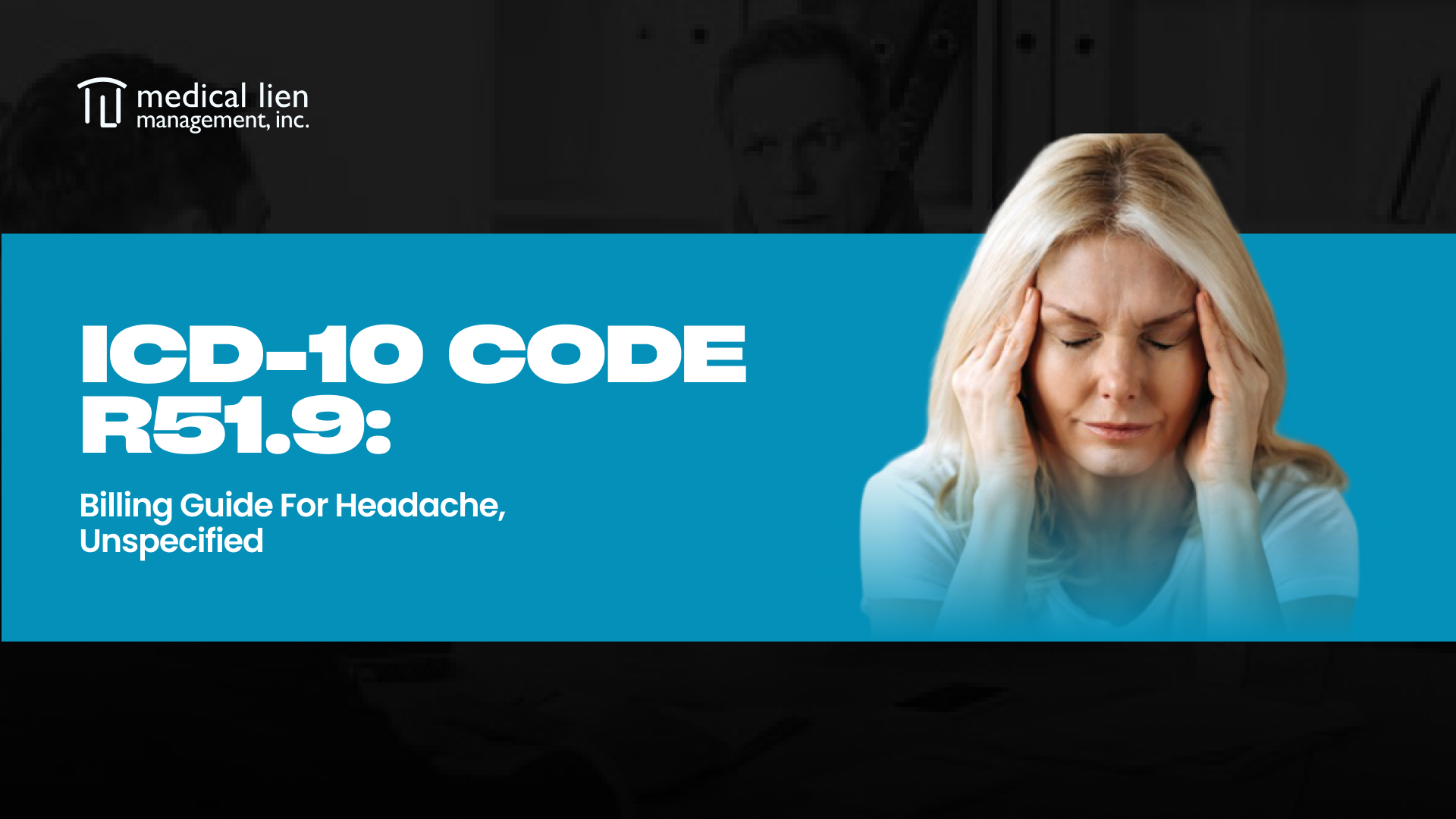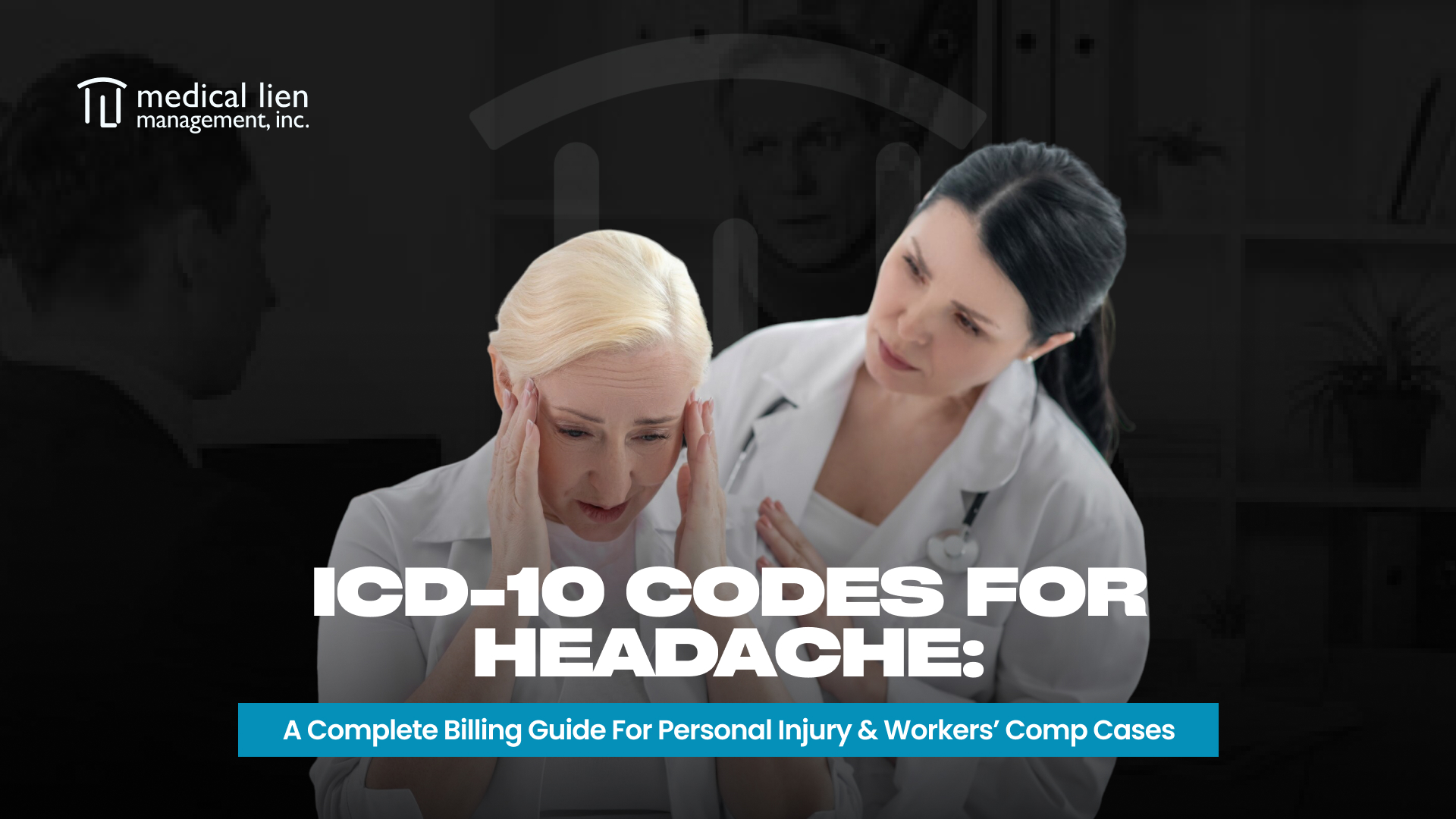Headaches that appear after an injury can be difficult to diagnose and even harder to code correctly in lien billing. Some patients experience headaches that worsen with posture changes, making the condition more complex for personal injury and workers’ compensation providers. This guide explains what ICD-10 code R51.0 (Headache with orthostatic component) means, when to use it, when to avoid it, and how Medical Lien Management (MLM) helps providers code accurately, submit liens faster, and minimize denials through compliant billing practices.
What Is ICD-10 Code R51.0?
ICD-10 Code R51.0 is defined as:
“Headache with orthostatic component”
(ICD-10-CM R51.0)
This code applies to headaches that worsen with upright posture and improve when lying flat. It is often associated with conditions such as:
- Cervical spine trauma
- Spinal fluid leaks
- Post-concussion syndromes
- Postural blood pressure shifts
- Neck or spinal vascular dysfunction
In the context of personal injury billing, R51.0 is critical when patients present with post-trauma headaches that correlate with postural changes, a common result of auto accidents or workplace falls.
How It Differs from R51.9
| Code | Description | When to Use |
| R51.0 | Headache with orthostatic component | When posture changes impact headache severity |
| R51.9 | Headache, unspecified | When no further clinical detail is available (use only if absolutely necessary) |
Why it matters: R51.0 offers greater specificity, which strengthens the medical-legal documentation in lien-based cases, improves settlement support, and reduces denials from insurance payers.
Why Accurate Coding Matters in Personal Injury Billing
ICD-10 codes are more than technical classifications, they are critical evidence in lien cases. An incorrect or vague code can:
- Trigger claim denials
- Delay resolution
- Undermine the connection between injury and symptoms
For PI and work comp billing in California, showing a clear link from accident → symptom → treatment necessity is essential. ICD-10 code R51.0 is an example of how accurate coding supports both clinical truth and legal justification.
“Accurate diagnosis coding demonstrates clear medical causation, a crucial factor in lien reimbursement success.”
When used correctly, R51.0 does more than describe the patient’s condition; it helps validate that the injury is directly connected to the event in question, a key factor in negotiations with insurers or defense attorneys.
When to Use ICD-10 Code R51.0 (And When Not To)
Knowing when to apply R51.0 is essential in headache billing. Here’s a practical checklist:
Use R51.0 When:
- The headache intensifies when standing and improves when lying flat.
- The condition developed after a documented trauma, such as a car crash or workplace fall.
- Diagnostic notes confirm orthostatic sensitivity.
- Imaging or neuro evaluation points to spinal trauma, CSF leak, or postural instability.
Avoid R51.0 When:
- There is no positional component reported or tested.
- The cause of headache is unclear or due to general tension or migraine.
- The provider has not documented any orthostatic behavior or symptoms.
- The patient presents with general headache and no trauma linkage.
Tip: Always pair R51.0 with an external cause code (V00–Y99) if the headache follows an accident. This supports claim validation.
Example:
- V43.52XA: Car driver injured in collision with stationary object
- Y04.0XXA: Assault by bodily force, initial encounter
Documentation & Billing Best Practices
The strength of your ICD-10 billing depends on the clarity and specificity of your documentation.
Medical Documentation Must Include:
- Onset and progression of symptoms
- Notes on positional triggers (e.g., “headache worsens on standing”)
- Duration and severity
- Response to treatment
- Link to incident or trauma
Code Pairing:
Use Evaluation & Management CPT Codes (99203–99215) alongside R51.0 for patient visits.
Include procedural codes for:
- Neurological evaluations
- Spinal imaging (MRI/CT)
- Head upright tilt testing, if applicable
Cross-reference:
Ensure attorney documentation, medical reports, and superbills match the coding and clinical records. Inconsistencies delay settlements and reduce reimbursement success.
Ensure your lien billing for headache cases is accurate and defensible. Book a Discovery Call with MLM’s certified coders to simplify ICD-10 documentation for faster payments.
Common Mistakes to Avoid When Billing R51.0
Avoiding common coding and documentation pitfalls ensures your lien isn’t delayed or denied.
1. Using R51.9 Instead of R51.0
If postural symptoms exist, using a non-specific code can reduce payout or fail to justify treatment.
2. Missing Accident Linkage
Never forget to include an external cause code (V00–Y99) that connects the condition to a qualifying event.
3. Vague Physician Notes
Notes like “patient has a headache” are insufficient. Use detailed language:
“Patient reports increased headache intensity when upright. Symptoms began after MVA on 09/12/2025.”
4. Not Indicating Acute vs. Chronic
If the headache has persisted for more than 90 days, document the progression. Update diagnosis codes as needed to reflect changes.
How MLM Simplifies Headache Billing
For over 30 years, Medical Lien Management (MLM) has helped medical providers through focused personal injury billing services in California, with a strong focus on lien claims and trauma-related diagnoses.
Here’s how MLM makes it easier:
- Certified ICD-10 Coders
Our expert team selects precise, defensible codes tailored to lien-based cases. - Jet Filing System
Proprietary technology that ensures fast, error-free submissions, helping providers get paid faster and reducing denials. - Legal Support for Lien Disputes
We coordinate with attorneys, respond to insurer challenges, and ensure your documentation supports the settlement process.
Whether you’re treating postural headaches, concussions, or complex trauma cases, MLM streamlines the entire billing cycle, from scheduling and RFA filing to collections and appeals.
Partner with MLM to simplify your personal injury billing process and ensure your headache claims get paid, in full and on time. Book a Discovery Call!
Conclusion
ICD-10 code R51.0 is the right choice when billing orthostatic headaches linked to trauma or postural dysfunction.
Correct use improves lien defensibility, avoids denials, and supports full reimbursement.
With MLM’s support, your billing is accurate, compliant, and fast-tracked for resolution, so you can focus on patient care while we handle the rest.
FAQs
What does intractable headache mean?
An intractable headache is a persistent, difficult-to-treat headache that does not respond well to standard therapies. It often requires more aggressive treatment and may be coded under G44.221 or G43.119, depending on the type.
What’s the difference between R51.0 and R51.9?
- R51.0: Specific to headaches that are worse when upright and better when lying down.
- R51.9: Used for unspecified headaches, should be avoided if more detailed information is available.
- R51.0 is the preferred code when positional symptoms are documented post-trauma.
What is diagnosis code D51.0?
D51.0 refers to Vitamin B12 deficiency anemia due to intrinsic factor deficiency. It is unrelated to headaches and not used for neurological symptoms like orthostatic headaches.
What CPT codes support R51.0 billing?
Use standard E/M codes like:
- 99203–99205 (New patient visits)
- 99213–99215 (Established patient visits)
If imaging or neurological assessments are conducted, additional CPTs may apply depending on service.




